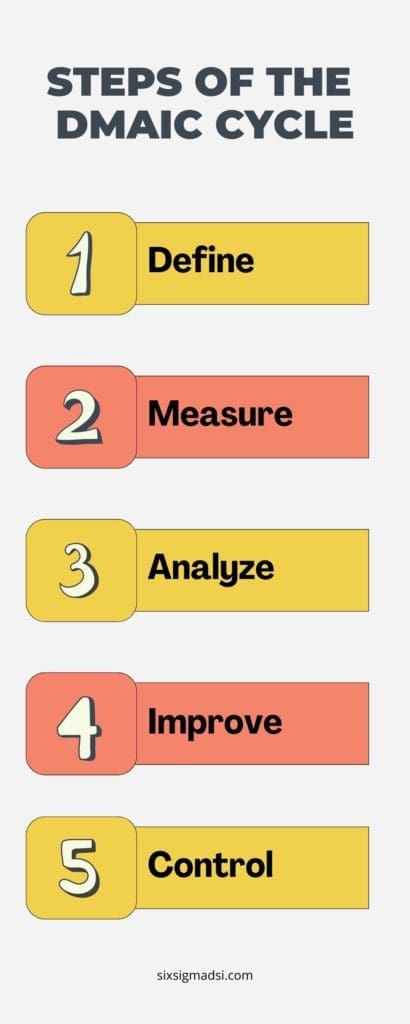Table of contents
What is a Six Sigma Event?
A Six Sigma event is a business management strategy with levels that aims to achieve near perfection in a process by identifying and removing the causes of defects and minimizing variability in manufacturing and business processes. It is defined as a process that produces results with no more than 3.4 defects per million opportunities. There can be a 1 Sigma, 2 Sigma, 3 Sigma, 4 Sigma, 5 Sigma, and 6 Sigma event.
Six Sigma Methodology
DMAIC and DMADV are the main Six Sigma methods. Each business has its own recommended procedure to implement for business transformation.
DMAIC uses data-driven methods to improve products and services in order to increase customer satisfaction. It stands for five phases: D – Define, Measure, Analyze, I – Improve, and C – Control. DMAIC can be used in the manufacture of a product or the delivery of a service.
DMADV is a component of Design for Six Sigma (DFSS). It’s used to design, re-design, or modify different manufacturing processes or delivery methods. D – Define, M – Measure, A — Analyse, and D – Design are the five phases of DMADV. DMADV can be used when existing processes are not meeting customer requirements, even after optimization or when new methods are required. Six Sigma Green Belts, Six Sigma Black Belts, and Six Sigma Master Black Belts execute it. The belts will be discussed later.

Six Sigma Events and What They Mean
1 Sigma Event
A 1 Sigma event refers to a process that produces results with 68% accuracy or 68% of outcomes falling within a standard deviation from the mean. In other words, it means that the process has a 68% chance of producing results within normal variation, while the remaining 32% of outcomes fall outside the expected range. In contrast, a Six Sigma event refers to a process that produces results with 99.99966% accuracy or 99.99966% of outcomes within the expected range. The goal of Six Sigma is to improve processes to reach this level of accuracy or better.
2 Sigma event
A 2 Sigma event refers to a process that produces results with 95% accuracy or 95% of outcomes falling within two standard deviations from the mean. In other words, it means that the process has a 95% chance of producing results within normal variation, while the remaining 5% of outcomes fall outside the expected range. The goal of the Six Sigma methodology is to improve processes to reach a level of accuracy closer to 6 Sigma, which would result in fewer defects or outcomes falling outside the expected range.
3 Sigma event
A 3 Sigma event refers to a process that produces results with 99.7% accuracy or 99.7% of outcomes falling within three standard deviations from the mean. In other words, it means that the process has a 99.7% chance of producing results within normal variation, while the remaining 0.3% of outcomes fall outside the expected range.
4 Sigma event
A 4 Sigma event refers to a process that produces results with 99.994% accuracy or 99.994% of outcomes falling within four standard deviations from the mean. In other words, it means that the process has a 99.994% chance of producing results within normal variation, while the remaining 0.006% of outcomes fall outside the expected range.
5 Sigma event
A 5 Sigma event refers to a process that produces results with 99.97700% accuracy or 99.97700% of outcomes falling within five standard deviations from the mean. In other words, it means that the process has a 99.97700% chance of producing results within normal variation, while the remaining 0.02300% of outcomes fall outside the expected range.
6 Sigma event
A Six Sigma event refers to a process that produces results with 99.99966% accuracy or 99.99966% of outcomes falling within six standard deviations from the mean. In other words, it means that the process has a 99.99966% chance of producing results within normal variation, while the remaining 0.00034% of outcomes fall outside the expected range.
How to Achieve a Six Sigma Event?
Achieving a Six Sigma event typically involves following the DMAIC levels (Define, Measure, Analyze, Improve, Control) process:
- Define: Clearly define the problem, process, customer requirements, and project goals.
- Measure: Collect data and establish a baseline for the current process performance.
- Analyze: Identify the root causes of defects and variability using statistical analysis and data-driven methods.
- Improve: Develop and implement solutions to eliminate the root causes of defects and variability.
- Control: Establish and maintain control systems to sustain the improvements made and prevent regression.
Additionally, Six Sigma uses data-driven decision-making, project management, and statistical analysis tools and techniques to achieve its goals. A trained Six Sigma professional, known as a “Black Belt” or “Green Belt”, leads each project.

Six Sigma Techniques
Six Sigma also employs a combination of statistical and data analysis tools, such as process mapping and design, and proven qualitative or quantitative techniques to reach the desired result.
Brainstorming
Brainstorming is a key part of any problem-solving process and is often used in the “improve” phase of DMAIC. This is an essential step before any tool can be used. Through group discussions and intensive brainstorming, ideas are shared and new solutions are developed. The facilitator is usually the Green Belt or Black Belt who facilitates the open sessions among the participants.
Root Cause Analysis/The 5 Whys
This technique is used to identify the root cause of problems and is part of the DMAIC cycle’s “analyze” phase.
The 5 Whys technique asks the question “why”, repeatedly, until it leads to the core issue. While “five” is the most common number, it can be adjusted to meet your needs.
Customer Voice
This is the process of capturing the customer’s voice or feedback through internal and external channels. This technique is designed to provide the best products or services for the customer. This technique captures the customer’s changing needs through both direct and indirect methods. In the “define” phase of DMAIC, the voice of customer technique is used to identify the problem to be solved.
The 5S System
The Japanese principle of workplace energy has the roots of this technique. The 5S System is designed to eliminate waste and bottlenecks caused by inefficient tools, equipment, or resources at work. These five steps are Seiri, Seiton (Set in Order), Seiso(Shine), Seiketsu (“Standardize”), and Shitsuke (“Sustain”).
Kaizen (Continuous Improvement)
Kaizen is a powerful strategy to create a continuous engine of business improvement. Continuous monitoring, identification, and execution of improvements are what Kaizen is. This is especially useful for the manufacturing industry. This is a great way to reduce waste and make immediate changes if there are any inefficiencies.
Benchmarking
Benchmarking refers to a method that uses a standard measurement. This involves comparing the situation with others businesses. Benchmarking can be used to compare critical processes and departments within a company (internal benchmarking), or to compare similar work areas with industry leaders (functional benchmarking). It also allows you to compare similar products or services with those of your competitors (competitive benchmarking).
Poka-yoke (Mistake Proofing)
The Japanese phrase “to avoid mistakes” is the name of this technique. It entails preventing errors from happening. The poka-yoke method allows employees to spot inefficiencies and human mistakes during manufacturing.
Value Stream Mapping
To design future projects, the value stream mapping technique maps the flow of information and materials. It is designed to eliminate waste and inefficiencies from the value stream and create more efficient operations. It lists seven types of waste as well as three types of waste disposal operations.
Have you been able to achieve 6 Sigma in any of your projects?
Tell us about your experience in the comments below.



















